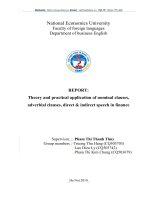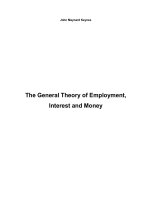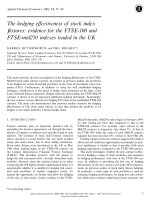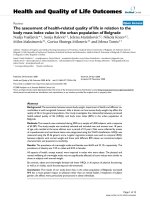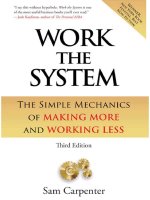Applied value investing the practical application of benjamin graham and warren buffetts valuation principles to acquisitions, catastrophe pricing and business execution
Bạn đang xem bản rút gọn của tài liệu. Xem và tải ngay bản đầy đủ của tài liệu tại đây (4.61 MB, 305 trang )
Praise for Applied Value Investing
“Calandro’s clever application of value investing principles to corporate decision-making could transform how businesses operate and
what business school students are taught. This thought-provoking
work takes value investing to the next level.”
—Seth A. Klarman, president, The Baupost Group, L.L.C.;
lead editor of Graham and Dodd’s Security Analysis, Sixth
Edition; and author of Margin of Safety
“After seventy-five years, Graham and Dodd remains the true North
Star for those seeking the Rosetta Stone to unlock values. Professor
Joseph Calandro adopts Graham and Dodd’s fundamental premises
and uses them to focus on new dynamics.”
—Mario J. Gabelli, CFA, chairman and CEO, GAMCO
Investors, Inc.
“Calandro’s application of Graham and Dodd principles outside the
traditional realm of value investing involves multi-disciplinary thinking, a necessary skill for constructively framing and reframing the
investment landscape in today’s chaotic world. Particularly interesting
is Calandro’s chapter on the relationship between Graham and Dodd’s
discussion of the market valuation cycle of greed and fear, and the top
down macro ideas of George Soros. In essence, Calandro shows how
Mr. Market’s bipolar psychology can be linked to Soros’ concepts of
reflexivity and feedback between conditions on Wall Street and Main
Street. Given the wild downward oscillations we have experienced
over the last year, every value investor should be able to weave these
two investment approaches together to understand when and why a
cycle develops, and where market behavior diverges significantly from
the fundamentals.”
—Mitchell R. Julis, co-chairman and co-CEO, Canyon
Partners, L.L.C.
“Joseph Calandro’s Applied Value Investing is the most important business book of our time. Today our global economy is in the throes of
major readjustment, and this book’s analysis is a critical navigation
tool to help executives and investors find and create value. Calandro
extends the classic work of Graham and Dodd to evaluate mergers and
acquisitions, catastrophe-based alternative investment, and most
importantly integrates it with a strategic framework for managers to
determine if they are truly creating value above their cost of capital,
risk adjusted. It is also well written, practical, and an enjoyable read.”
—Dr. John J. Sviokla, vice chairman, Diamond Management
& Technology Consultants, and former associate professor of
Harvard Business School
“For anyone interested in the interface between strategy and finance—
CEOs, CFOs, operations executives, planners, investors, analysts, and
risk managers—Applied Value Investing by Joseph Calandro, Jr. offers
two key lessons that are potentially extremely rewarding. One is that
business leaders can find new sources of competitive advantage if they
learn to think like highly successful investors. The other is that investors and analysts can gain valuable insights if they study how a company achieves the creative interaction of strategy, resource allocation,
performance management, and risk management. In other words,
investors should learn to think like astute business leaders. Calandro’s
groundbreaking book integrates these two lessons into a holistic and
practical business framework, which can be used to either assess or
manage a business.”
—Robert M. Randall, editor, Strategy & Leadership, and
coauthor of The Portable MBA in Strategy
“This is an extremely smart book. The three chapters on M&A alone
are worth the price of admission. If executives will adopt the discipline
that Joseph Calandro lays out, they will avoid many, many costly
mistakes.”
—Paul B. Carroll, coauthor of Billion-Dollar Lessons: What
You Can Learn from the Most Inexcusable Business Failures of
the Last 25 Years
“Joseph Calandro successfully applies the modern approach to Graham and Dodd’s investment valuation. The book is a ‘must read’ for
all Graham and Dodd followers, and valuation practitioners.”
—Patrick Terrion, principal, Founders Capital Management,
and author of The Company You Keep: A Commonsense Guide
to Value Investing
“A useful addition to every value investor’s library.”
—Bruce Greenwald, Robert Heilbrunn Professor of Finance
and Asset Management, Columbia Business School
“You will enjoy learning from real world cases how to apply the investment principles of the legendary Benjamin Graham and Warren
Buffett. Because of outstanding writing and some fascinating corporate and financial history, this book is an excellent way to learn how
to be a successful investor.”
—Dr. Thomas J. O’Brien, professor of finance, University of
Connecticut, and author of International Finance: Corporate
Decisions in Global Markets
This page intentionally left blank
APPLIED
VALUE
INVESTING
This page intentionally left blank
APPLIED
VALUE
INVESTING
the practical applications of
benjamin graham’s and
warren buffett’s
valuation principles to
acquisitions, catastrophe pricing,
and business execution
JOSEPH CALANDRO, JR.
New York Chicago San Francisco Lisbon London Madrid
Mexico City Milan New Delhi San Juan Seoul
Singapore Sydney Toronto
Copyright © 2009 by Joseph Calandro, Jr. All rights reserved. Except as permitted under the
United States Copyright Act of 1976, no part of this publication may be reproduced or distributed in any form or by any means, or stored in a database or retrieval system, without the prior
written permission of the publisher.
ISBN: 978-0-07-162819-8
MHID: 0-07-162819-3
The material in this eBook also appears in the print version of this title: ISBN: 978-0-07-162818-1,
MHID: 0-07-162818-5.
All trademarks are trademarks of their respective owners. Rather than put a trademark symbol
after every occurrence of a trademarked name, we use names in an editorial fashion only, and to
the benefit of the trademark owner, with no intention of infringement of the trademark. Where
such designations appear in this book, they have been printed with initial caps.
McGraw-Hill eBooks are available at special quantity discounts to use as premiums and sales
promotions, or for use in corporate training programs. To contact a representative please e-mail
us at
This publication is designed to provide accurate and authoritative information in regard to the
subject matter covered. It is sold with the understanding that neither the author nor the
publisher is engaged in rendering legal, accounting, futures/securities trading, or other
professional service. If legal advice or other expert assistance is required, the services of a
competent professional person should be sought.
—From a Declaration of Principles jointly adopted by a Committee of the American Bar
Association and a Committee of Publishers
TERMS OF USE
This is a copyrighted work and The McGraw-Hill Companies, Inc. (“McGraw-Hill”) and its
licensors reserve all rights in and to the work. Use of this work is subject to these terms. Except
as permitted under the Copyright Act of 1976 and the right to store and retrieve one copy of the
work, you may not decompile, disassemble, reverse engineer, reproduce, modify, create
derivative works based upon, transmit, distribute, disseminate, sell, publish or sublicense the
work or any part of it without McGraw-Hill’s prior consent. You may use the work for your own
noncommercial and personal use; any other use of the work is strictly prohibited. Your right to
use the work may be terminated if you fail to comply with these terms.
THE WORK IS PROVIDED “AS IS.” McGRAW-HILL AND ITS LICENSORS MAKE NO
GUARANTEES OR WARRANTIES AS TO THE ACCURACY, ADEQUACY OR
COMPLETENESS OF OR RESULTS TO BE OBTAINED FROM USING THE WORK,
INCLUDING ANY INFORMATION THAT CAN BE ACCESSED THROUGH THE WORK
VIA HYPERLINK OR OTHERWISE, AND EXPRESSLY DISCLAIM ANY WARRANTY,
EXPRESS OR IMPLIED, INCLUDING BUT NOT LIMITED TO IMPLIED WARRANTIES
OF MERCHANTABILITY OR FITNESS FOR A PARTICULAR PURPOSE. McGraw-Hill and
its licensors do not warrant or guarantee that the functions contained in the work will meet your
requirements or that its operation will be uninterrupted or error free. Neither McGraw-Hill nor
its licensors shall be liable to you or anyone else for any inaccuracy, error or omission,
regardless of cause, in the work or for any damages resulting therefrom. McGraw-Hill has no
responsibility for the content of any information accessed through the work. Under no
circumstances shall McGraw-Hill and/or its licensors be liable for any indirect, incidental,
special, punitive, consequential or similar damages that result from the use of or inability to use
the work, even if any of them has been advised of the possibility of such damages. This
limitation of liability shall apply to any claim or cause whatsoever whether such claim or cause
arises in contract, tort or otherwise.
For Terilyn,
Forever
This page intentionally left blank
CONTENTS
Preface
xi
Acknowledgments
xxv
Chapter | 1 The Basics and Base-Case Value
1
Introduction
1
Base-Case Valuation
7
Conclusion
18
Chapter | 2 Base-Case Value and the Sears Acquisition
21
Introduction
21
The Rise and Fall of Sears
23
Valuing Sears
25
Postacquisition Performance
37
Chapter | 3 Franchise Value and the GEICO Acquisition
41
Introduction
42
GEICO
43
Valuing GEICO
45
Postacquisition Performance
57
Appendix: Estimating GEICO’s Discount Rate
59
• vii •
viii • Contents
Chapter | 4 The Gen Re Acquisition and Franchise Risk
65
Introduction
66
Gen Re and the Business of Reinsurance
67
Valuing Gen Re
69
Postacquisition Performance
81
Conclusion
86
Appendix: Assessing the Risk of M&A
90
Chapter | 5 Macroanalysis, Opportunity Screening,
and Value Investing
109
Introduction
110
Business/Boom-Bust Cycles
113
The Eight Stages of a Business Cycle
115
Recovery
121
The “New Economy” Business Cycle
122
New Economy Recovery
133
Post New Economy Business Cycle Activity
138
Conclusion
151
Appendix 1 – Warren Buffett and Efficient
Market Theory
152
Appendix 2 – A Practical, Reflexive
Fundamental Proxy
Appendix 3 – Enron
154
156
Chapter | 6 A Graham and Dodd–Based Approach to
Catastrophe Valuation
159
Introduction
159
Background
160
Valuation
163
Contents • ix
Postmortem and Guidelines
170
Conclusion and a Word on Catastrophe Bonds 176
Chapter | 7 Financial Strategy and Making Value Happen
179
Introduction
179
Strategy Formulation
183
Resource Allocation
184
Performance Management
189
Risk
190
Financial Strategy
193
Conclusion
197
Conclusion
201
Introduction
201
Screening
202
Initial Valuation
205
NAV Adjustments
213
EPV Assumptions
215
Franchise Validation
215
Growth Valuation
216
Final Valuation
218
Conclusion
219
Resources
223
Endnotes
231
Index
265
This page intentionally left blank
PREFACE
Investment is most intelligent when it is most businesslike.
—Benjamin Graham1
Berkshire Hathaway chairman and CEO Warren Buffett described
this quote as “the nine most important words ever written about
investing,”2 which is significant given his level of success as both an
investor and businessman. Buffett both studied under and worked for
the late Benjamin Graham, the founder of what has come to be
known as value investing.3 Value investing is a method of analysis that
has spawned a large number of highly successful investors since it was
first introduced in the 1930s. It has also been the subject of a number
of popular books, including Graham’s own works, such as
●
The seminal Security Analysis, which he coauthored with David
Dodd in 1934 and updated in subsequent editions, the most recent of which was published in 2008 and edited by noted value
investor Seth Klarman
●
The popular Intelligent Investor, which was first published in
1949 and also updated in subsequent editions, the most recent
of which was edited in 2003 by financial author Jason Zweig
• xi •
xii • Preface
The books that followed Graham’s essentially have presented different interpretations of value investing, broadly defined, and are generally introductory in nature. This book takes a different approach;
rather than introducing a new variation on the value investing theme,
it adopts the modern Graham and Dodd approach and applies it in
a variety of unique and practical ways. Specifically, the modern
Graham and Dodd approach is applied to a number of practical casebased valuations that
●
Demonstrate how the Graham and Dodd approach could be
used in a mergers and acquisitions (M&A) context. This could
be significant, for while Graham and Dodd–based valuation has
been highly influential in the investment community (traditional and alternative alike), it has thus far not had the same level
of influence on the practice of corporate M&A.
●
Explain how macro-related insights can be used in a Graham
and Dodd context.
●
Show how the basic concepts of Graham and Dodd valuation can be applied to the emerging area of catastrophe-based
alternative investments.
●
Incorporate the practice of valuation into an integrated business framework that can be used to either assess or manage a
franchise (which is a firm that is operating with a sustainable
competitive advantage).
In short, this book extends the modern Graham and Dodd approach
in a number of ways that, it is hoped, will prove useful to current and
future practitioners of the discipline. The book is structured with
seven chapters and a Conclusion that summarizes an applied value
Preface • xiii
investing approach and clarifies several practical aspects of it for
implementation purposes.
The first chapter reviews the basic concepts of net asset valuation
and earnings power valuation, the first two levels of Graham and
Dodd–based valuation, and it introduces the base-case value profile
via a case study of an actual equity investment.
The second chapter builds on the foundation of the first by applying base-case valuation to M&A by way of Edward Lampert’s 2004
acquisition of Sears. This case is the first of four relatively high-profile
valuation case studies, and thus it is important to note that I have
no special information on any of those valuations other than what is
publicly available.4 Furthermore, the case studies are not meant to
imply that either Edward Lampert or Warren Buffett approaches
valuation in the manner presented here. Rather, the cases are presented to demonstrate the practical utility (and research viability) of
the modern Graham and Dodd approach via actual investments
made by two of the approach’s most successful disciples.
In Chapter 3, the concept of a growth-based margin of safety
is discussed in the context of Warren Buffett’s highly successful
acquisition of GEICO in 1995. While growth-based margin of safety
acquisitions can be incredibly successful, as the GEICO case fairly
dramatically demonstrates, the intangible nature of growth carries
with it substantial risk. This risk is illustrated in Chapter 4 through
another Buffett acquisition, this one being the 1998 acquisition of the
General Reinsurance Corporation (Gen Re).
The fifth chapter pertains to a topic that is not frequently addressed
from a Graham and Dodd perspective: macro-based analysis. Relatively few people would disagree with the statement that two of the
most successful investors of the late twentieth century were Warren
xiv • Preface
Buffett and George Soros. Despite the long-term investment success
that both of these men have in common, the approaches they use are
vastly different: Buffett uses a bottom-up approach that is rooted in the
Graham and Dodd tradition, whereas Soros uses a seemingly eclectic
top-down or macro-based approach.5 Just how different these
approaches are was illustrated, for example, several years ago at an
investment conference that I attended.
During a question-and-answer session at the conference, I asked a
presenter about integrating macro-based analysis and value investing.
He replied that it would probably be easier to unify gravity and quantum mechanics—the celebrated “theory of everything” that Albert
Einstein tried to derive in the final decades of his life, and that current
theoretical physicists are diligently working on—than it would be to
integrate macro-based analysis and value investing. That reply was
obviously said in jest, but it did highlight the fundamental differences
between the two approaches. Those differences, however, need not
be considered insurmountable. Furthermore, there is much that practitioners (and researchers) of each approach could learn from the
other. Toward that end, Chapter 5 presents a method of analysis that
can be used to assess and evaluate business cycles from a Graham and
Dodd–based perspective, and applies this method to a case study of
the recent “new economy” boom and bust, and its aftermath.
Chapter 6 changes gears somewhat by addressing catastrophe-based
alternative investments, which are relatively new instruments that have
grown in popularity in recent years. This chapter extends the basic
concepts of Graham and Dodd to the field of super catastrophe valuation by way of the Pepsi Play for a Billion sweepstakes case. This case
study pertains to the pricing of a super catastrophe–based, insurance
policy–like alternative investment that was underwritten by a Berkshire
Preface • xv
Hathaway subsidiary in 2003. The chapter ends with overview commentary on the somewhat related field of catastrophe bond valuation.
Chapter 7 is the capstone of the book and has its roots in the famous
quote of Benjamin Graham that is found at the beginning of this
Preface, namely, “Investment is most intelligent when it is most
businesslike.” Despite the inherent and long-standing logic of this
quote, many investors currently do not think like businesspeople.
Furthermore, many businesspeople do not think like investors. This
divergence even applies to academia in that finance, management,
and strategy professors tend to approach their subjects (and their
research) very differently, often with very little overlap across
disciplines.6 Chapter 7 provides one approach for integrating these
disciplines into a holistic and practical business framework that can
be used to either assess or manage a franchise over time.
Finally, in the Conclusion, I highlight some of the key lessons of
the book, and I also provide some practical suggestions for implementing an applied value investing approach. The Conclusion is followed by a description of additional information sources that could
be referred to by those interested in exploring the Graham and Dodd
approach further.
In addition to the subject matter, this book differs from many that
precede it in that all of the chapters are based on material that has
been published academically, specifically, in the Journal of Alternative
Investments, Strategy & Leadership, the Quarterly Journal of Austrian
Economics, the Business Strategy Series, and Measuring Business
Excellence. I am grateful to the editors of each of these publications
for allowing me to develop and expand the research that they
published for a broader audience. That said, it is important to point
out that the formal foundation of this book’s chapters should not be
xvi • Preface
interpreted to mean that the book is not practical. The Graham and
Dodd approach to investing is inherently practical, as its track record
since it was first introduced vividly illustrates.
Nevertheless, and according to Professor Bruce Greenwald, who
teaches value investing at Columbia University, the Graham and
Dodd approach is also a “legitimate academic discipline.”7 I, for one,
agree with this statement, but I am apparently in the minority. For
example, if one were to look for Graham and Dodd–based published
research, one would essentially find material that empirically shows
that the approach does, in fact, work, along with applied case studies
published by me and my coauthors.*
Empirical studies have a place in value-based research programs,
but so do formal case studies. Furthermore, using Graham and Dodd
concepts in M&A, in conjunction with macro-based analysis, in super
catastrophe valuation, and as part of an integrated analytical business
framework appear to be viable avenues for future research and study.
If this book helps to inspire such research, while at the same time
assisting Graham and Dodd–based practitioners, it will have achieved
its objectives.
THE EDUCATION OF A LATE-BLOOMING
GRAHAM AND DODDER
I started my business career in the insurance industry while I was still
in college. Several years later, in 1992, Hurricane Andrew struck
* Thanks to Ranga Dasari (my former student) and Scott Lane (my former professor) for
collaborating with me on the GEICO valuation, and to Bob Flynn (friend and fellow traveler)
for collaborating with me on the Gen Re valuation and the financial strategy paper.
Preface • xvii
southern Florida, and the devastation that this storm caused convinced me that the insurance industry would soon be undergoing
substantial changes. To better understand those changes, I began a
relatively intense research program on a variety of economic and
financial topics. Therefore, when the first catastrophe bond issue
emerged in the mid-nineties, it did not come as a surprise to me; on
the contrary, I sensed that this type of vehicle would grow in popularity, so I began studying derivatives. Me being me, after a period of
study, I decided to try my hand at trading, and I did very, very well at
it, even though trading was not my full-time job: I did all of the analysis and tactical decision making after hours. This obviously took a
substantial amount of time, but I am a natural workaholic with a very,
very understanding spouse, so I was able to manage the work flow
rather well.
After four extremely profitable years, my trading fortunes changed
in 1997–1998 as a result of the “Asian contagion,” which Roger Lowenstein wrote about so well in his 2001 masterpiece that was aptly
titled When Genius Failed. While I did not blow out as a result of the
contagious volatility, my portfolio did experience a substantial decline.
More significantly, however, I did not understand why the decline
had occurred: according to the models that I was using at the time,
such a loss was just not supposed to happen (at least not in my hopefully long lifetime), and yet it did happen, and it happened to me.
After the Asian contagion, I stopped trading so that I could figure
out what exactly had happened and why I had missed it so completely.
At the time, the “new economy” boom was underway, and, also significantly, I did not understand why that was happening either. I knew
that the economy was not new, but I did not know why so many other
people thought that it was. Yes, the Internet itself was new, and yes, it
xviii • Preface
had a great deal of potential (for example, were it not for the Internet,
it is very doubtful that I would have ever written this book or the
papers that preceded it), but the telephone had been new a hundred
years before and it had not ushered in a new economy, so why would
the Internet?
And then something else happened: Warren Buffett acquired the
firm that I was working for at the time, Gen Re. He paid approximately $22 billion for that firm against a book value of approximately
$8 billion, which was a hefty premium for the world’s foremost value
investor. At that time, a number of my friends asked me to explain the
rationale for this acquisition to them, but I could not make sense of it
either.
Three significant financial economic events had happened (the
Asian contagion, the new economy boom, and Buffett’s purchase of
Gen Re), and I could not explain or make sense of any of them. That
simply was not acceptable to me, so I decided to engage in a different
kind of research program. For example:
●
I bought and studied everything I could find on Benjamin Graham and value investing.
●
I downloaded and studied all of Warren Buffett’s shareholder
letters.
●
I began to study Austrian economics, which is a school of
economics that is often ignored by mainstream economists. I
reasoned that, as mainstream economics (and economists) are
frequently wrong—many times spectacularly so—perhaps an
alternative school would provide a greater level of practical insight.
Preface • xix
In retrospect, that was an incredibly good decision. First, the inherent logic of Benjamin Graham’s approach was immediately compelling to me. I also began to find linkages in Graham’s writings with
some of the business cycle (or boom-bust) work that Austrian economists had published. In this regard, Security Analysis was first published in 1934, which was after the “new era” boom of the “roaring
twenties” had ended (Graham started teaching value investing at
Columbia in 1928, during the new era boom). And yet, Graham’s
description of the new era seemed eerily similar to some of the things
that I was then witnessing during the new economy of the 1990s.8 My
findings are covered in Chapter 5 of this book.
I also found Warren Buffett’s shareholder letters very compelling,
as so many others appropriately have. The letters are very candid documents, and they give great advice on what to do, but they do not tell
you how to do it. This is consistent with the structure of many books
on investing in general, meaning that they give great advice on what
to do, but they really do not explain how, exactly, to do it. Therefore,
to get a better understanding of the nuts and bolts of the Graham and
Dodd approach, I decided to attend the executive version of the value
investing course that is offered at Columbia University every year.
The firm that I was working for at the time would not pay the tuition
for the course, so I paid for it myself and attended the sessions on my
vacation (again, I have a very understanding spouse). Fortunately, my
monetary and time commitments were very much a “value investment,”
because from the very first session with Professor Bruce Greenwald, the
Graham and Dodd approach became extremely clear to me.
I began to apply the approach immediately, and the first case
I analyzed was the Gen Re acquisition. I showed the valuation that
xx • Preface
I came up with to people who were familiar with M&A at the time,
and they were extremely interested in it. Significantly, I later showed
the valuation to others who were familiar with the deal, and they were
also impressed with it. That valuation is the subject of Chapter 4 of
this book.
I then evaluated Buffett’s GEICO acquisition. A number of articles
have, appropriately, been published on that acquisition, and it is also
the subject of a popular University of Virginia case study. However,
no one had ever evaluated GEICO from a Graham and Dodd perspective before, at least not publicly. So I did, and once again the
M&A specialists that I showed it to were impressed with the result.
That valuation is the subject of Chapter 3.
Around this time, I was approached to teach at the University
of Connecticut. The chair of that institution’s finance department
at the time, Tom O’Brien, had read a number of my papers and
inquired whether I would be interested in teaching. After preliminary
discussions, it was agreed that I would teach two MBA courses, one of
which would be on value investing. As part of the course, I wanted to
bring in practicing value investors as guest speakers, and I was very
fortunate to secure two of the best: Mario Gabelli, the legendary
mutual fund manager, and Robert Wyckoff of Tweedy, Browne
Company.
I left regular teaching after a couple of years to take a position in
the consulting industry. As luck would have it, my first consulting
engagement entailed a substantial valuation, which helped to make
the transition to consulting rather seamless for me. Publishing papers
can be an important part of a consulting career, so I started to publish
the value-based research that I had produced, beginning with my
valuation of the Pepsi Play for a Billion case, which you will find as
